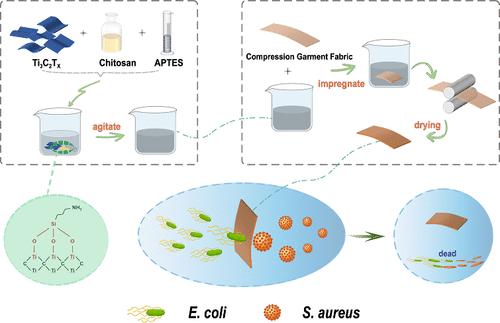基于 Ti3C2Tx-Citosan-APTES 材料的压缩服装面料抗菌整理
IF 5.3
2区 材料科学
Q2 MATERIALS SCIENCE, MULTIDISCIPLINARY
引用次数: 0
摘要
穿着压力衣(CG)可以有效预防和治疗增生性疤痕(HS),但压力衣的表面容易滋生细菌。因此,对压力衣织物(CGF)进行抗菌整理尤为重要。为了达到协同抗菌、提高抑菌率、增强生物安全性的目的,本研究制备了一种由 MXene(Ti3C2Tx)、壳聚糖和氨基硅烷偶联剂(3-氨基丙基)三乙氧基硅烷(APTES)组成的复合材料及其抗菌 CGF。探讨了抗菌复合材料与 CGF 的结合机理,研究了抗菌 CGF 的抑菌率、耐磨性和耐洗牢度。结果表明,Ti3C2Tx、壳聚糖和 APTES 与 CGF 共价键合,实现了协同抗菌效果。未经水洗的抗菌 CGF 对革兰氏阴性菌大肠杆菌(E. coli,AATCC 6538)和革兰氏阳性菌金黄色葡萄球菌(S. aureus,AATCC 25922)的抑菌率均达到 99.9%,耐洗牢度达到 AA 级。此外,抗菌整理织物的舒适性在一定程度上受到了挠曲刚性和透气性的影响,但总体而言,抗菌 CGF 的耐磨性也能满足患者的日常穿着需求。本文章由计算机程序翻译,如有差异,请以英文原文为准。

Antibacterial Finishing of Compression Garment Fabric Based on Ti3C2Tx–Chitosan–APTES Material
Wearing a compression garment (CG) can effectively prevent and treat hypertrophic scars (HS), but the surface of CG is prone to bacterial growth. Therefore, it is particularly important to carry out antibacterial finishing on compression garment fabric (CGF). In order to achieve the purpose of synergistic antibacterial action, improving bacteriostatic rate, and enhancing biological safety, this study prepared a composite material of MXene (Ti3C2Tx), chitosan, and amino silane coupling agent (3-aminopropyl)triethoxysilane (APTES) and its antibacterial CGF. The binding mechanism between the antibacterial composite material and the CGF was explored, and the bacteriostatic rates, wearing properties, and wash fastness of the antibacterial CGF were studied. Results showed that Ti3C2Tx, chitosan, and APTES were covalently bonded to the CGF, achieving synergistic antibacterial effects. The antibacterial CGF without washing showed a bacteriostatic rate of 99.9% against both Gram-negative bacteria Esherichia coli (E. coli, AATCC 6538) and Gram-positive bacteria Staphylococcus aureus (S. aureus, AATCC 25922), with washing fastness reaching grade AA. Additionally, the comfort of the antibacterial finishing fabric was affected to a certain extent in terms of flexural rigidity and air permeability, but overall, the wearability of the antibacterial CGF also met the daily wearing needs of patients.
求助全文
通过发布文献求助,成功后即可免费获取论文全文。
去求助
来源期刊

ACS Applied Nano Materials
Multiple-
CiteScore
8.30
自引率
3.40%
发文量
1601
期刊介绍:
ACS Applied Nano Materials is an interdisciplinary journal publishing original research covering all aspects of engineering, chemistry, physics and biology relevant to applications of nanomaterials. The journal is devoted to reports of new and original experimental and theoretical research of an applied nature that integrate knowledge in the areas of materials, engineering, physics, bioscience, and chemistry into important applications of nanomaterials.
 求助内容:
求助内容: 应助结果提醒方式:
应助结果提醒方式:


